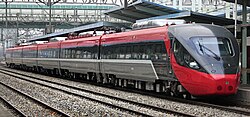Korail
Korail is the name of the national railroad operator in South Korea.
 | |
| Government-owned corporation | |
| Industry | Mass transit |
| Founded | September 1, 1963 as Korean National Railroad January 1, 2005 split into Korail and KR |
| Headquarters | Soje-dong, Dong-gu, Daejeon, South Korea |
Key people | Huh, Joon-Young (President, CEO) |
| Products | Railroad and subway transportation |
| Website | www.korail.com |
| Korea Railroad | |
|---|---|
| Operation | |
| Infrastructure company | KR |
| Statistics | |
| Ridership | 969,145,101[2] |
| Passenger km | 31,415,965,207[2] |
| Freight | 10,553,675,728 ton km[2] |
| System length | |
| Total | 3,558.9 kilometres (2,211.4 mi) |
| Double track | 1,865.3 kilometres (1,159.0 mi) |
| Electrified | 2,356.7 kilometres (1,464.4 mi) |
| High-speed | 368.5 kilometres (229.0 mi) |
| Track gauge | |
| Main | Lua error in package.lua at line 80: module 'Module:Track gauge/data' not found. |
| High-speed | Lua error in package.lua at line 80: module 'Module:Track gauge/data' not found. |
| Electrification | |
| AC 25,000V 60Hz | 2,337.5 kilometres (1,452.5 mi) |
| DC 1,500V | 19.2 kilometres (11.9 mi) |
| Features | |
| No. stations | 652 |
| Highest elevation | 855 metres (2,805 ft) |
| at | 37°12′0″N 128°56′59.83″E / 37.20000°N 128.9499528°E |
| Korail | |
|---|---|
| Hangul | 한국철도공사 |
| Hanja | 韓國鐵道公社 |
| Revised Romanization | Hanguk cheoldo gongsa |
| McCune–Reischauer | Han’guk ch‘ŏldo kongsa |
Lines
Currently, Korail runs the railway and part of subway. The list of railway consists of Gyeonbu line경부선, Honam line호남선, Jeolla line전라선, Janghang line장항선, Gyeongchun line경춘선, Jungang line중앙선, Chungbuk line경북선, Yeongdong line영동선, Taebaek line태백선,Gyeongbuk line경북선, Daegu line대구선, donghae Nambu line동해 남부선, Gyeongjeon line경전선, Gyeongui line경의선, Gyeonwon line경원선, based on their district. Gyeonbu and Honam line is the main lines that across the South Korean Peninsula. Not only this, Korail also offers Tongguen line통근선 service in some districts. In addition to these lines, some of subway lines of Seoul also are run by Korail.
Train Classes
Korail train contain many kinds of train such as KTX, saemaul-ho, mugunghwa-ho and nuriro.[3]
KTX is the highest level of trains. It is served on Gyeongbu and Honam line. Saemaul-ho train is next fastest and comfortable train after KTX. It is offered on wider range of lines than KTX. Mugunghwa-ho train is more generally used as a low-priced but slow train. It is offered on almost all lines. Nuriro train has similar level of price and speed with Mugunghwa-ho, but it serves less and shorter sections than the Mugunghwa-ho, from Seoul to Singchang.
Rail Passes
Korail has many kinds of passes.[3]
First, there are some passes available in specific area. For example, with O-train pass, people can take O-train off the V-train on Jungang, Chungbuk, Yeongdong, Taebaek, and Gyeongbuk line. Also, with S-train pass, you can take part of Gyeonbu, Honam, Jeolla, donghae Nambu, and Gyeongjeon line.
There is also a pass for youth, which is Rail-ro. People who are under 25 can use it in the summer and winter season.(June 1st - August 31th, December 31th - February 28th).[4]
Korail offers a rail pass called Korea Rail Pass, or KR Pass for short, to foreign travellers. The pass lets foreign travellers take most of the trains that Korail runs, including KTX. But subways and tourist trains by Korail are not covered.[5]
Foreigners living in South Korea for more than six months are not allowed to use the KR Pass. Korail has another pass for these people, the Happy Rail Pass, which is the same as the KR Pass but more expensive.[5]
Korail also sells a Korea-Japan Joint Ticket together with JR Group, including both railways in South Korea and Japan, as well as a high-speed ferry trip between Korea and Japan (or a round trip, depending on the pass). However, the pass cannot be used for KTX, and the holders need to buy an extra ticket (with a 30% discount).[5]
Korail Media
References
- ↑ 1.0 1.1 "2010 Statements of Income". Korail. Archived from the original on 2013-06-29. Retrieved 2013-05-28.
- ↑ 2.0 2.1 2.2 National Statistics Portal, not available in English. Retrieved 15-2-2010
- ↑ 3.0 3.1 http://www.korail.com
- ↑ "자유 여행 패스 - 내일로". Archived from the original on 2013-06-01. Retrieved 2013-12-18.
- ↑ 5.0 5.1 5.2 "Official Site of Korea Tourism Org.: Railroad Passes". Archived from the original on 2013-08-10. Retrieved 2014-01-02.


